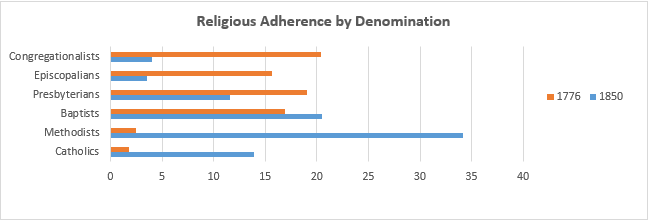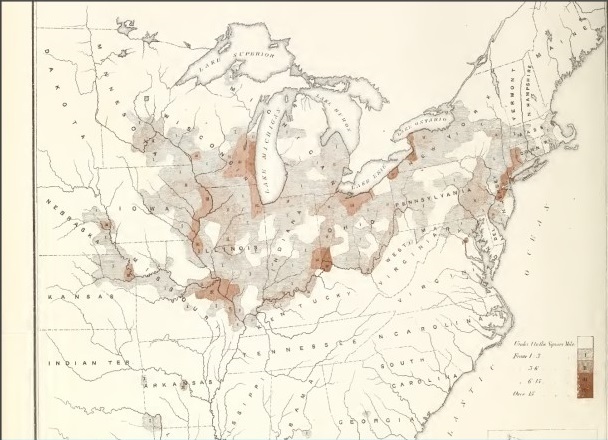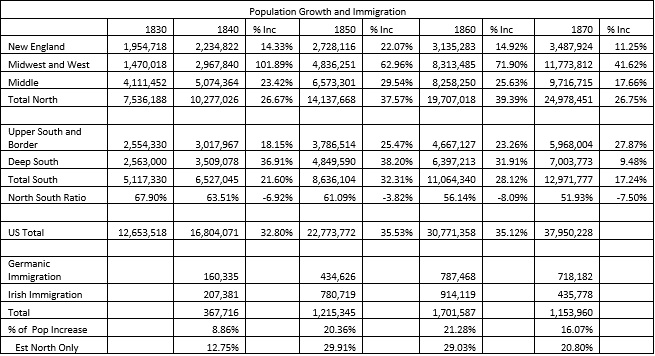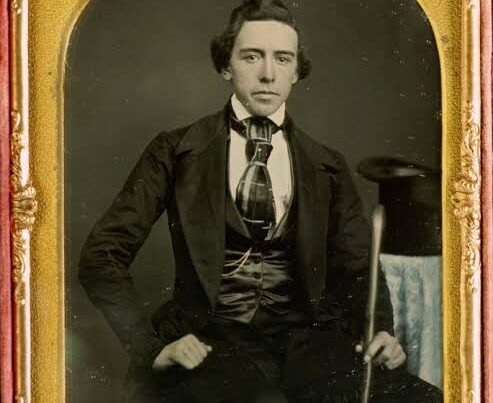
The role of religion, specifically evangelical protestant religion in the North, is frequently emphasized by gatekeeper historians in framing the causes and consequences of the War Between the States. This stands today as a sort of creation myth for the recreated Nation. Because survey data on individual religious affiliation and participation is not available for this time period, anecdotal evidence from prominent religious figures from New England is cited but how representative were these activists and commentators?
Authors Roger Finke (Penn State) and Rodney Stark (Baylor University) devised a method to estimate religious adherence or participation based on church land records correlated to detailed church attendance records where they exist to create relationships between seats or pews and participation levels for individual denominations. The time period around the war starting in 1850 is especially data rich in that the Census Bureau captured data on seats, buildings, and land value from congregations in the census reports. This was known about and ignored for decades but when used in statistical models is very accurate in establishing participation levels that match samples where detailed records of church attendance have survived from the time. When these correlation factors are applied to all churches at a state and even local level the results are very interesting in addressing a number of questions ranging from the role of abolitionists leading up to the war to explaining the decline in Protestant Christianity in the North and expansion in the South in the decades after the war.
National Origins: Before addressing the war of 1861 however, it is important to establish a baseline going back to the colonial time period in order to understand the rapidly unfolding demographics of the young nation. Based on educational curriculum and collective memories most see the original colonists as being devout Christians seeking religious freedom and economic opportunity. This makes for a firm starting point from which John Winthrop’s “Shining City on a Hill” can develop giving us a somewhat messianic national identity. The problem is though, none of its true. Starting with the most basic question of assessing what the real participation or adherence level was, Fink and Stark estimate that in 1776 it was around 17% and other similar estimates generally range between 10% and 20%. For reference, estimates for different periods going forward are shown in the table below.

So why such a low starting point? People that come to frontier areas are younger and more male dominant than established populations so reasonably one wouldn’t expect colonial America not to be highly religious but this doesn’t even begin to paint a complete picture. We all have some knowledge of the app 600K slaves brought from Africa (sold by African kingdoms) to the colonies and the young nation (about 5% of the total brought to the Americas) but only about 150K of 450K Europeans who came here came willingly during the colonial period per ship logs were free, the rest were indentured servants who sold their freedom willingly, generally based on false promises, who were called “free willers”. The Africans who were brought here before around 1660 or 70 were actually indentured servants also and not permanent slaves. For the first several decades of settlement relatively few of these servants survived to be free. But wait, it gets worse, in addition to these there were 10’s of thousands of stolen British and Irish, mainly children, who were sold in the colonies. This was a major form of organized crime in England in this time period and was especially heartless. This practice is where the terms “kidnapped” and “spirited away” came from. Add to that similar numbers of mostly petty or subsistence criminals, prisoners of war, vagrants (street urchins in Dicken’s portrayal) and you get the picture of what the American population really consisted of. Virtuous and committed pilgrims dragging themselves off to church services in the snow, not exactly. Most know that Australia was a penal colony but the American colonies were where Britain offloaded its unwanted population prior to that. It did however provide a ready mission field which was to become important. (Note that this doesn’t necessarily mean that the regional subcultures weren’t to varying degrees nominally or culturally Christian)
Awakening and the Rise of the Upstarts: The First and Second Awakenings transformed the religious landscape although it could be contended that these didn’t represent distinct periods but a general trend starting in New England then expanding outward where two upstart groups, the Methodists and Baptists became dominant while the established churches remained steady or contracted. The Methodists and Baptists had a simple message, were not closely connected to educational institutions of seminaries, had a lower cost structure using bi-vocational clergy in many cases, and were self-funding and not linked to the government. To use a term from modern business management, they were agile.
In 1776, the religious participation of the different regions was fairly consistent with the middle colonies being slightly less than the Northern and Southern colonies but there were a couple of non-homogenous sub groups that stand out. The upper elements of society (“political class” or “ruling class”) were significantly more likely to be religiously affiliated, at least publically, than lower economic classes and that affiliation was almost always with one of the legacy protestant denominations specifically the Anglicans / Episcopalians, Congregationalists, or Presbyterians. Recognizing that, such a thing as a ruling class exists isn’t necessarily bad in that all organizations do have some sort of hierarchy and there are both legitimate and illegitimate reasons for this, it should also be recognized that the thoughts and beliefs of this group are going to be proportionally of greater importance. The other key observation is that the Congregational Church, the established church of New England, has virtually no presence outside of New England but was very influential there.
As we follow the data forward to 1850 there are some striking changes that occur in the denomination makeup that are apparent even in aggregate data that isn’t separated by state or region.

Finke and Stark, Churching of America, page 56 (percent of religious adherents)
The state established churches (Congregationalists and Episcopalians) had collapsed. Some of this is due to immigration of primarily Germans and Irish but they really weren’t able to even maintain their own base. Another factor is that the cost structure imposed by professional clergy and the universities/seminaries made it difficult to reach low income dispersed markets. The establishment model of being supported by the government also made them lazy and unmotivated. A strong case can be made, however, that the biggest factor was liberalization and secularization. While secularization generally reflects the evolving views of a group’s leadership, statistically it is very clear this causes dramatic losses in membership and participation. Still the wealthy, powerful, and influential remained predominantly from these two groups.
The Road to War – Secularism and the Progressive Church: Looking at regional and denominational data there are some clear regional trends reflecting evolving differences in northern and southern society. The following two tables show denominational adherence by region in 1850 and 1860 respectively calculated using regression values to correlate seats to people taken from Fink and Stark. Property and regional differences in age distributions are not considered but the data is within a small margin of error from a known dataset that included these additional variables.
Assessing trends based of a small number of datasets is generally unadvisable but the tendencies this point out continue and even accelerate when extended to 1870 and 1890 which are the next available data points. A good deal of anecdotal information shows that protestant Christianity in the North was secularizing and also moving toward a degree of unification by 1840 at the latest and arguably as early as 1820.


Puritan Secularism: The regional totals while being fairly consistent are somewhat misleading. In New England the liberal congregational church had spawned even more secularized offshoots of Universalists, Unitarians, and Transcendentalists that were concentrated in this area causing the total to be slightly inflated by groups that would generally be considered cults.
Quakers: A statistically insignificant group that does show up prominently in abolitionist’s history as well as in relation to temperance/prohibition and other progressive social movements are the Quakers or Society of Friends. Quakers were concentrated in Pennsylvania and the Northeast.
Catholics: Catholic numbers, due to Irish and Germanic immigration, in the New England, the West and Midwest, and in the central colonies were growing very rapidly and this would continue through the end of the century and into the 1900’s creating a deep political rivalry. The political church in the North was entirely protestant taking the lead of the Congregationalists and associated groups while the Catholics were virtually all Democrat at this time (see Cross of Culture by Kepler). Progressive Christianity in the north had a pool of people to draw on that was not ever greater than about 23% of the adult population. Interestingly the Catholic immigrants to the northeast didn’t appear to be closely affiliated with the church initially but puritan persecution coupled with effective clergy and lay leadership created a strong Catholic ethno-religious culture.
Established Churches: The Congregationalists remained regional and were declining. People of this background continued to control the political narrative in the North. Episcopalians and Presbyterians remained small with an upper class orientation.
The Upstarts: The Baptists and the Methodists were the most dynamic. The Baptists in the North were declining and fragmenting. There is a good deal of anecdotal evidence that Northern Baptists were becoming increasing secular and political and were working closely with other groups as diverse as Unitarians. Their decline in the North would continue through 1870 and then stabilize by 1890. In the South Baptists were steady both doctrinally and in terms of numbers. Methodists were the dominant group and were growing in all regions but after 1860 they would start a consistent decline in the North. The Methodists in the North were in many cases highly political rivaling the Congregationalists.
Free Thinkers and 48er’s: From 1830 through the remainder of the century there was very heavy non-English European immigration which significantly changed the culture, demographics, and politics in the North. During the years around the war this specifically referred to Germanic peoples including eastern Europeans (note modern nation state boundaries weren’t formed yet) and Ireland. Settlement patterns for the two groups were similar stretching from New England and New York across the upper Midwest with Germanic immigrants being more heavily concentrated in the west and Irish along the East Coast. In all other respects they were very different.


The Irish immigrants were fleeing the famine and seeking economic opportunity and their numbers peaked and dropped off sharply by 1870. They were overwhelmingly poor and not politically active. Specifically they lacked any progressive or Marxists leanings. The Germans and eastern Europeans were another matter. They frequently came with some wealth and became independent farmers or merchants. A sizeable percentage were also “free thinkers” or “48er’s” who were fleeing the aftermath of the failed socialist revolutions. There were a large number prominent people from this group that fit into the Republican Party and the Union Army. At the time they were called “Red Republicans” and saw nationalism as an interim step towards globalism. But what about this demographic as a whole apart from tracking specific individuals? Religious affiliation can provide a clue.

Lutherans in the Midwest would have been predominantly Germanic however we see no significant increase in Lutheran participation. Germanic immigrants could also be Catholic or possibly Methodist and the Catholic percentages do increase but not as much as in New England. Because Catholics and Germanic Lutherans generally favored small and limited government and voted overwhelming Democratic at the time, a “free thinker” would strongly tend not to associate with these groups (See Cross of cultures). The increase in the Catholics numbers could also be explained by Irish so that point is inconclusive. Religious data does infer that a solid majority of the Germanic immigrants in the years leading up to and just after the war were in fact “48ers” and that their population was dense enough in certain areas to be a major political force. (Note: Table also shows the relative population problem facing the Confederacy and effect of mass immigration on demographics)
Sectional Differences in Christian Teaching and Culture: Ultimately, while the same denominations generally operated in the North and South, the religious culture was very different. Historians of various backgrounds who have looked at this topic consistently come up with similar conclusions. I will present several below without further comment other than to note that the writers are not necessarily Southern nor orthodox Christian, yet are largely consistent.
The new pietism took different forms in various regions of the country. In the South it became personalist, or salvational: the emphasis was on each person achieving the rebirth of salvation on his own rather than via social or political action. In the North, especially in the Yankee areas, the form of the new Protestantism was very different. It was aggressively evangelical and postmillennialist, that is, it became each believer’s sacred duty to devote his energies to trying to establish a Kingdom of God on Earth, to establishing the perfect society in America and eventually in the world, to stamp out sin and to make America holy, as essential preparation for the eventual Second Advent of Jesus Christ. Each believers duty went far beyond mere support for missionary activity, for a crucial part of the new doctrine held that he who did not try his best to maximize the salvation of others would not himself be saved…
Murray Rothbard, “The Progressive Era”
Among the earliest settlers of the American wilderness, the Puritans of New England were animated by a powerful consciousness of who they were, what they had fled from, and the new world they were laboring to redeem and build for themselves and all mankind in North America. They were a people powered by an unmistakable sense of mission and of being the objects of a divine covenant with all its attendant blessings and curses. The Puritans were set apart to be, as John Winthrop famously and enduringly labeled them, a “City upon a hill” with the eyes of the world fixed upon them. God entered into a literal new covenant with a new chosen people, called out of bondage in Egypt for a particular task at a special moment in redemptive history, escaping from a modern Pharaoh and his army across a great sea. Their election was confirmed by signs and wonders, by attesting miracles of deliverance and safety and provision. They were unshakably certain of God’s calling. They fled from a corrupt Europe and from an England bound in spiritual decline and apostasy. Or, to change the biblical metaphor, they were the woman of the book of Revelation (12: 14-17) who fled the dragon and escaped into the wilderness.
Richard Gamble, War For Righteousness, Introduction, page 7
The Pilgrims and, to a greater extent, the Puritans came to the New World not to re-create rural English life but rather to build a completely new society: an applied religious utopia, a Protestant theocracy based on the teachings of John Calvin. They would found a new Zion in the New England wilderness, a “City on a hill” to serve as a model for the rest of the world in troubled times. They believed they would succeed because they were God’s chosen people, bound to Him in an Old Testament-style covenant. If they did his will, they would be rewarded. If any member did not, they might all be punished. In early Massachusetts, there was no such thing as minding one’s own business; the salvation of the entire community depended on everyone doing their part.
American Nations, Colin Woodward, Chapter 4, page 57
Southern Churches overwhelmingly supported the confederacy not out of support for slavery or any of the other social issues that were developing at the time. They did so because these were seen as political issues that couldn’t be clearly addressed using “scripture only” and they were right on this point being consistent with Christian tradition. I would summarize by simply saying that Southern religion, while having protestant evangelical doctrines existed within a cultural context more representative of the remnants of Christendom while the church in the North were children of the enlightenment.
Conclusions: In recent decades history education, under the revisionist influences of Straus, Jaffa, and others has stressed philosophical motivations in explaining group actions as opposed to more tangible considerations like economics, demographics, and technology emphasized by writers like Charles and Mary Beard. Even if one was to accept this premise, to make a case that a particular belief or collection of beliefs drove major historical events in a grass roots sense it would still have to be established that those beliefs were broadly representative of a society as a whole. If we were further to assume that all protestant Christians and offshoot groups in the Union states were fully supportive of the doctrines of Progressive Christianity of the time period which included abolitionism, temperance, centralization, and ultimately a global political vision or mission this would represent only about 22% to 23% of the population. But how realistic is this?
Within any church at any time there are varying levels of agreement and commitment to positions taken by church leadership. There were also pockets of resistance to progressive Christianity in the North, which were the beginnings of modern fundamentalism, that would drive this figure down but it is difficult to assess how much as this doesn’t necessarily mean they rejected the social and political goals. A comparative data point developed by historian Thomas De Lorenzo based on Abolition Society roles is that no more that 2% of the Union population were active abolitionists and these were concentrated in New England and comprised of social classes that typically don’t fight wars. These would be the true believers. With the exception of the Methodists, all the major protestant groups in the North were declining by 1860 and continuing and generally accelerating through 1870 which further indicates the progressive message was having the same effect it always does which is drive away members although this was somewhat hidden because of a rapidly expanding pollution base. A reasonable estimate of the percentage of the population that was to some degree supportive of the abolitionist goals of immediate and uncompensated termination of slavery would probably be no more than around 10% of the total adult population with a strong regional bias.
A more plausible and supportable conclusion is the positions of the progressive protestant church did strongly represent the prevailing opinions in Northern elite society. It also dominated northern culture and literature from the time and was disproportionally politically influential but was not broadly representative of the general population nor did it dominate Union politics. Moreover it would be advisable for modern mainstream Christians who tend to point to abolitionism as a victory for social action to understand this was part of a larger collection of beliefs and positions and to research what these people really did believe and, as important, didn’t believe.
After the War: The Methodists reached their peak in 1850 and started to decline after that (in terms of percentages). The Baptists continued to grow and by the 1920 had overtaken the Methodists as the largest denomination. There are a couple reasons for this but both have to do with the sectional association of the Baptists with the South. Fink and Stark observe that so long as a religious group operated in some degree of tension with the broader culture (definition of a sect) they flourish. On the other hand, when a religious group fully blends into their social environment they go into decline. Further the process of normalization and decline starts with more affluent lay leaders and the seminaries that produce the clergy.
Because the Methodists were less statistically biased towards the South in the first place, the general decline of the evangelical Protestantism in the North had a larger effect than it did on the Baptists. I would propose, however, that southern Christianity could be seen as a sect, or in tension with the broader American society, because the South as a region and as a culture existed in tension with American society that was dominated in all respects by the victors and their puritan culture that by the 1900’s was largely secularized but continued the underlying characteristics and behaviors. The counterpoint to this would be to say that Southern Religious culture changed significantly enough over time, mainly through the new fundamentalism that was becoming dominant, that the comparison isn’t consistent. The degree to which Christianity in Southern culture is unique from modern fundamentalist Christianity in general is very debatable as is its future course.
Sources and Recommended Reading:
- The Churching of America 1776 – 2005 Winners and Losers in Our Religious Economy, Roger Fink and Rodney Stark, Rutgers University Press, 2005
- White Cargo: The Forgotten history of Britain’s Slaves in America, Don Jordan and Michael Walsh, New York University Press,
- Puritan’s Empire – Catholic Perspective on United States History, Charles A Coulombe, Tumblar House, 2008
- US Census Table XVII-A and B, Statistics of Churches in the United States, Census of 1870 (summarizes 1850, 1860, 1870)
- Sacred Conviction: The South’s Stand for Biblical Authority, Joseph Jay, Shotwell Publishing, 2018
- Lincoln Unmasked, Thomas De Lorenzo, Three Rivers Press, 2006
- The Progressive Era, Murray Rothbard, Ludwig von Misses Institute, 2017
- American Nations, Colin Wodward, Penguin Books, 2012
- The War for Righteousness, Richard Gamble, ISM Books,
- A Fiery Gospel, Richard Gamble, Cornell University Press
- Where the Grapes of Wrath are Stored, John Devenny, 2019





